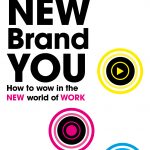 Most of us have low wattage on the visibility spectrum. We are unknown outside of a small network of friends and professional contacts. We are not bold-faced names.
Most of us have low wattage on the visibility spectrum. We are unknown outside of a small network of friends and professional contacts. We are not bold-faced names.
But visibility and its companion, fame, are things you should think about if you’re ambitious. We’re talking of fame on some level – it could be in your industry, or your company or the world.
We’re talking, most importantly, about being famous for something that’s special and different from others and is appealing to your target audience.
Taylor Swift is a wonderful case study in how smart brand building is done. Recently she was named Time magazine’s Person of the Year. She is now becoming a case-study in college MBA programs. Her Eras tour keeps breaking box office records and stimulating the local economies where it’s held. Government leaders are approaching her to perform in their counties.
She wasn’t just a dreamer of stardom when she was a young girl. She had talent as a singer and as a storyteller and the persistence to keep evolving through all her “eras.”
Her sweet spot as a singer: the angst of girls as they transition from girlhood to womanhood.
She internalizes the pain and turns it into music. The stories, the emotions she evokes are universal. Being authentic made her famous.
Job Seekers: 3 Tips for Looking the Part
Why should how you look make a difference in getting the job? As superficial as it may seem, looking the part does matter according to a new study by the Harvard Business School.
The HBS study analyzed 63,000 job openings and 160,000 freelance job seekers applying for those jobs. Certain accessories and physical features gave freelancers an edge, more than gender, age and ethnic background.
Here are 3 tips for job seekers looking for an edge:
1. Pay attention to the details: For your profile shot, forget the snaps with your dog or kids and chose a neutral background.
2. Choose accessories that telegraph visually a career fit: Recruiters favored certain looks. Having a computer visible and wearing glasses gave job hunters an edge in computer software programming jobs. People exploring design or media-related jobs did better – surprise – when they had a stylish “artistic” look often with fashionable glasses.
3. Having good references seals the deal: Success wasn’t just about looking the part. Having good references from your previous job along with looking the part was a game changer, often resulting in a 5 percent salary increase according to the HBS researchers.
#jobseekers, #lookingthepart
Who sells better?
Humans still outperform in sales studies.
For Now.
Sales has always been about more than what you say in a pitch. It’s how you say it. Right now AI is not as good as a real person in utilizing a voice’s rhythms, inflections and cadence (the mixing up of vocal expression). All of these things sway us to listen carefully and be persuaded.
The power of a real voice is not surprising. Everyone’s voice is unique as I point out in my new book, “The New Brand You.” For centuries, there was no written language. People listened to one another’s voices.
So if you’re in sales and in other client-facing fields, the challenge is clear. Companies are training bots to match the voices and cadences of successful sales people. As Oren Harnevo , CEO of Feel, a company involved in training bots pointed out in a WSJ interview, when that is accomplished, “It’ll be stupid to continue having humans and paying for them.”
The moral of this story? Ramp up the human touch factor – in your voice, body language and in your communications with others.
As successful people in sales know, humans crave other humans. Let’s keep it that way.
3 Tips for Building a Robust Personal Brand
To compete in today’s new world of work with hybrid, remote and in-person working, and AI beckoning, it pays to learn about personal branding. Branding is all about being recognized as someone who adds value to a business or career situation.Here are 3 tips:
1. Have a focused brand identity. Remember the Law of Singularity in branding. Being a Jack or Jill of all trades is no where’s ville in branding. If you can’t articulate your value in 10 words or less, go back to the drawing board.
2. Be different. Most people have a me-too brand that’s generic and something you’ve heard dozens of times before. You’ll always be perceived as second rate if you take that approach.
3. Be relevant. We live in a dynamic world and you need to keep up with what’s taking place and solve a problem that’s important today, not yesterday’s needs.
To learn more, click the link above to check out my interview on ASBN, America’s Small Business Network.
.
Branding Advice from Barbra Streisand

Many successful people have traits in common as Barbra Streisand points out in her new memoir, “My Name is Barbra.” Weighing in at 1000 pages, it’s full of tips and hefty enough to be part of your exercise program.
Here are 3 take-aways from the book:
• See yourself as a superstar from the beginning
Streisand’s success wasn’t just due to her talent and she’s got plenty of that and the awards to prove it. Yet we all know talented people who don’t realize their potential. She always aimed high. “I have never looked for jobs in the chorus,” she says in the book. “Frankly, I don’t think it even occurred to me. Working my way up slowly didn’t figure into my plan.”
• Perfectionism is the path to greatness
Barbara was a relentless perfectionist and no detail was too small. When she appeared on the Ed Sullivan show, the host had pronounced her name as Streis – land before the show. Worried that they might do it again live on air, she called out from backstage, “Streisand like sand on the beach.” Decades later, she called Tim Cook, CEO of Apple to correct Siri who pronounced her name as Strei – zand.
• Have a verbal and visual identity that stands out
Streisand understood that being different is important for a brand. Born Barbara, she had a pretty common name for a girl of her generation She figure]ed that she’s didn’t need the second “a,” so she dispensed with it. There’s only one Barbra and it’s Barbara Streisand. She famously
Let Your Clothes Talk like Travis Kelce
Strong visual identities are a quick read. And clothes are one of the quickest ways to communicate a message about who you are. Clothes often offer more insight than your words.
Stylish clothes are a personal branding tool not lost on celebrities, but move over Kardashians, now there’s Kansas City Chiefs tight end Travis Kelce.
According to the Wall Street Journal’s “On Trend “column this week, “Before his cleats touch grass on a game day, before he laces them up, Kelce said he takes at least three hours to pick out an outfit for walking into the locker room.” At last year’s Super Bowl, Kelce chose a Louis Vuitton patchwork overcoat. His goal he says is to bring a smile to someone’s face.
Now that he’s dating Taylor Swift, he’s upgrading to a $5 million dollar home in Kansas City. No doubt we can expect a sartorial step-up, too. His wardrobe with its 300 sneakers and scores of outfits, is stashed in a spare bedroom in his current house, but I’m betting his wardrobe is about to undergo the Swift treatment.
Don’t think clothing selection is a superficial thing. I used to think that dressing for success just made a difference in how other people see you. “Clothes make the man,” as Shakespeare says. But clothes can do even more than that, as I cover in my new book, “The New Brand You.”
What you wear can make a difference in job performance. You perform better because you feel more confident and powerful when you feel that you look good. The power of clothes as PR and performance booster seems to be working for Kelce. He is considered to be one of the best tight ends of all time, and he leads his team in receiving yards.
What’s the best move? Quiet Quitting v. Moving On
Things are not so happy on the job front these days.
After reaching its highest levels in 2020, employee engagement declined for the second year in a row according to a new Gallup study. Engagement, a key measure of job enthusiasm and involvement, is important because low engagement often results in quiet quiting that fosters employee unhappiness that often leads to job hunting.
Not surprisingly, Gallup’s survey of 60,000 people reported that 57% thought that it is a good time to look for a job.
Better than being a lethargic employee, better to do something about it. Analyze your grievances like better in-office policies and develop your target list.
You’ll also need a good pitch, a focused pitch that will get you noticed. In my new book, The New Brand You: How to Wow in the New World of Work, I outline the Top 10 Personal Positioning Strategies to stand out from competitors.
1. The Innovator: Are you a creative problem solver? Give examples
2. The Leader: Is your strength your ability to lead people and get things done? List key accomplishments
3. The Maverick: Do you have an unconventional approach that produces results? Share the ways.
4. The Superman: What’s the one strength you have in spades? Focus on this one attribute.
5. The Engineer: Are you adept at tweaking and improving things? Share your new processes you set up on the job.
6. The Expert: Are you an expert in one, important area? Focus on it.
7. The Target Marketer: Do you have a strong customer service orientation to one group of customers? Share the advantage in your job
8. The Elitist: Are you among the top tier in your line of work? Play up your elite credentials because not many people can claim them.
9. The Heir: Do you have a unique heritage and connections? Fit them in the interview narrative.
10. The Activists: Is there a special cause that you are passionate about that is important in your industry too? Demonstrate the power of commitment to a cause.
Focus on the best positioning that plays to your strengths and go for it. Imagine your best future with the flexibility, culture and opportunities you crave.
Summer Casual – But Can You Wear it to the Office Come September?
The lines between what is office appropriate and what isn’t have blurred since the pandemic. But how far can you go when you’re pulled back into the hybrid office?
You need to ask yourself, when people see you, what ideas pop up into their heads? Will they take you seriously if you’re wearing a cap with your favorite team’s logo on the front? You couldn’t have done it pre-pandemic in corporate America. But what about now?
Well it depends on the cap.
What about the baseball style cap worn by Logan Roy in the hit show, Succession. Roy’s hat appears ordinary. It doesn’t even appear to have a logo. (Of course, there is a logo, an almost invisible one.) As some fanatic viewers have pointed out, if you have a high-def television, you might observe the cashmere texture and hint of a logo.
The appeal of the cap is that it is so elite that only savvy One Percenters can even recognize that it’s no ordinary baseball cap. It’s a $625 cap made with luxurious baby cashmere by the elite Italian brand Loro Piana, owned by the luxury brand LVMH.
The cap is an example of quiet branding, a coded signifier of elite status and being in the know.
Al the WSJ points out in its article, “Cool, Casual” (August 12-13, 2023) the rules are different depending on the setting and where you stand in the hierarchy. The juniors “might get handslapped for a cap, though a partner can put one off with impunity. It’s the same with a director on a film can wear one – it’s a power move, but if you’re the intern, it’s not gonna fly.”
What do your sartorial choices say about you?
What Animal Are You in the Career Zoo?
What animal signifies Brand You?
Often in doing a brand assessment, asking focus group participants to identify what animal or car they associate with a brand is more enlightening than traditional analytical methods and questions.
Symbolic associations can be powerful branding. We all know the symbol of the United States, the bald eagle – it conveys power. But the bald eagle was not the only animals our founders considered. Other animal imagery debated was a cow with horns, a goose, a bear and a white-tailed deer. (See Stuart Halpern’s interesting article about the search for a symbol of the United States in the Wall Street Journal: July 1 – 2, 2023.
Even the British got caught up in the branding suggesting a zebra with 13 stripes, each symbolizing a state with Massachusetts strategically placed on the animals behind.
The eagle’s imagery had staying power and strong symbolism with 13 arrows in one claw and an olive branch in the other. Its powerful wings became a stymbol of liberty. Prominent on the eagle’s breast was the motto E pluribus unum Out of many, one.
The bald eagle also satisfied Benjamin Franklin’s desire for a native American bird representing America’s courage in breaking away from Britain.
So what animal represents you best. To find out what animal your strengths are most aligned with, take our animal assessment test https://www.selfbrand.com/tools/animalQuiz.html
Sometimes Age is An Asset in Personal Branding
How come silver-haired male stars are hot, but the older women, not so much? A recent WSJ headline said it all: “Harrison Ford is 80. He’s Proof: Silver-Haired Stars are the new Box Office Gold.”
Harrison Ford is back as “Indiana Jones.” Tom Cruise (60) stars in “Mission Impossible.” There’s Arnold Schwarzenegger (75) in “FUBAR” and Denzel Washington (68) in The Equalizer 3.” And Kevin Costner(68) stars in “Yellowstone.”
This silver-haired pack is successful not only because they are reviving beloved franchises, they ooze sex appeal.
Silver hair is not such an asset for women, though, especially in the corporate and media worlds. A year ago long ago Canadian news anchor Lisa La Flamme (58) says she was fired over letting her hair grow gray. Look at the young, attractive women who are the reporters and anchors on news shows in the U.S.
Looking back, Anne Bancroft was only thirty-six when she played the “older” woman, Mrs. Robinson in “The Graduate.” And Duston Hoffman was just six years younger and played someone her daughter’s age.
Feeling depressed yet?
There’s a lot to be said for ageing gracefully but it can be harder for women. Men with silver hair or no hair are often viewed as hunks but it’s less likely to happen to women. I’m all for trying to dial time back a bit by camouflaging gray hair and ditching the matronly clothes.
But nothing ages a woman more than desperately trying to look young.
There’s a way to do it. Look at the fashion attention that Iris Apfel has received. She’s hit 101 and has become a “geriatric starlet” with her bold clothes and oversize eyeglasses. She’s been transformed from a private person who did her own thing with clothes to a fashion icon who others consider a style authority and who’s being asked to judge fashion competitions and represent brands.






